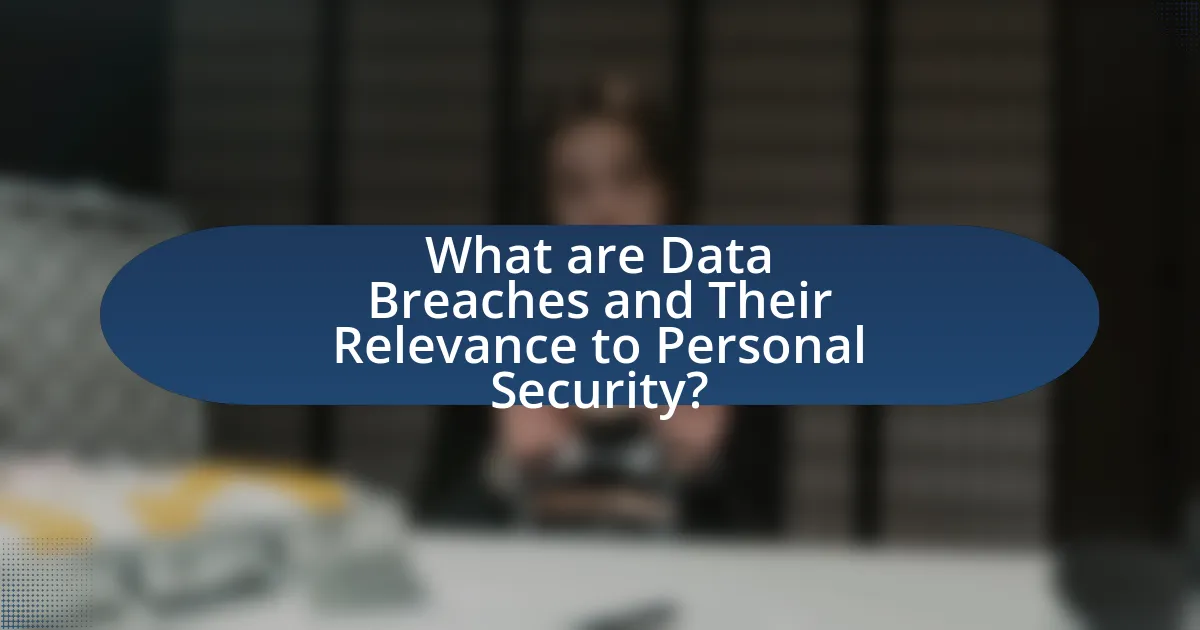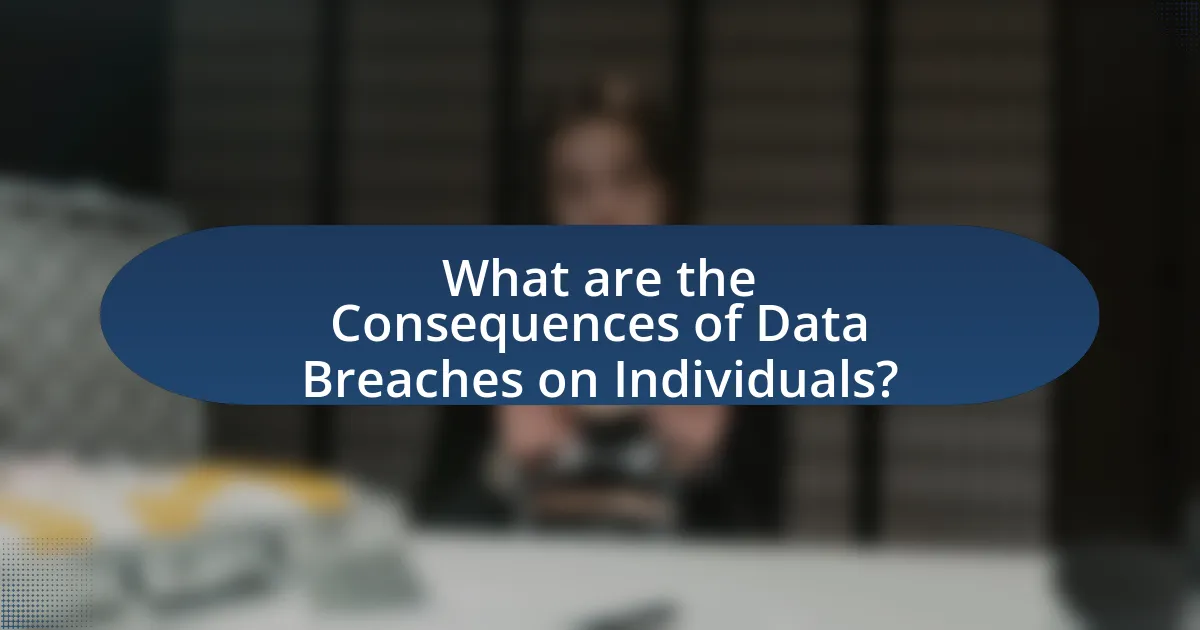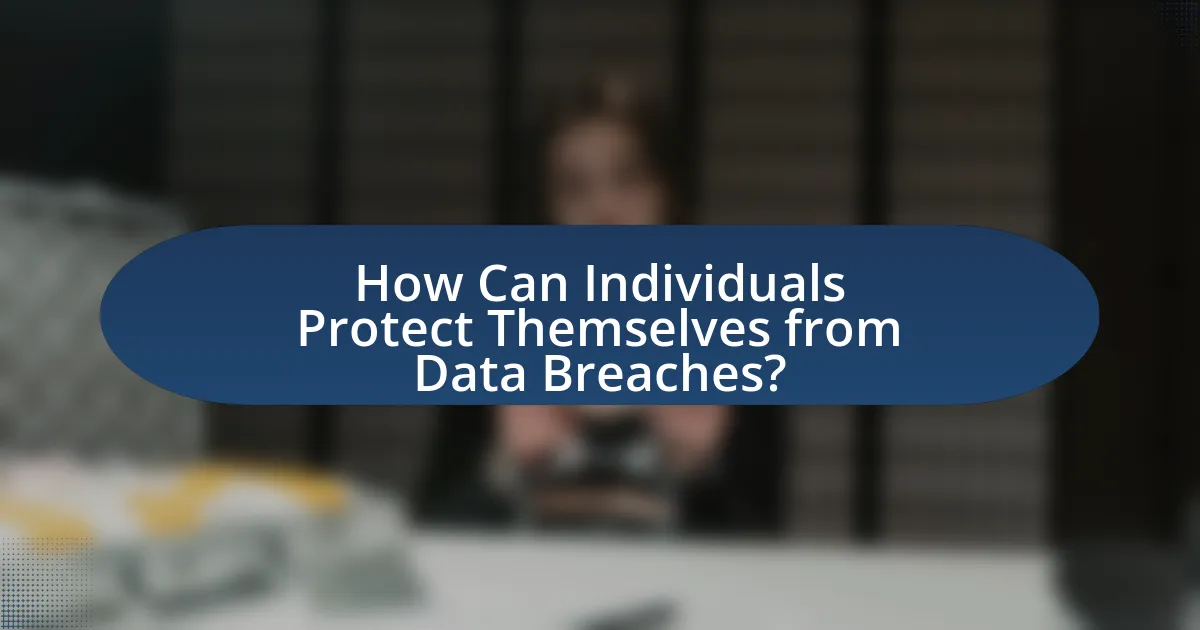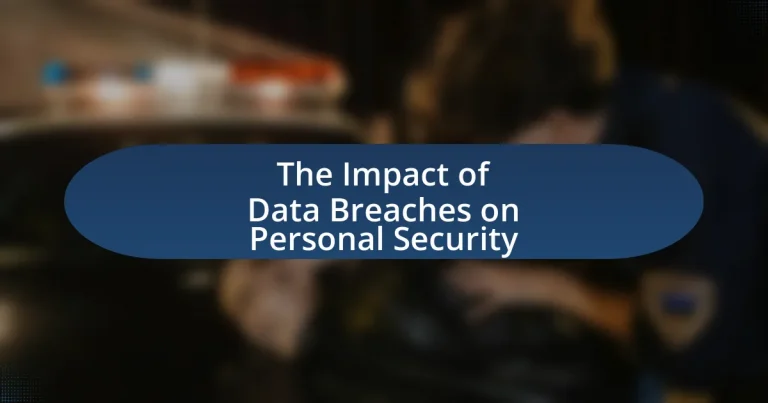Data breaches are incidents where unauthorized individuals access sensitive information, posing significant threats to personal security. This article examines the prevalence of data breaches, their causes, and the common methods employed by cybercriminals, highlighting the role of human error in these incidents. It discusses the immediate and long-term consequences of data breaches, including identity theft, financial loss, and psychological impacts on victims. Additionally, the article outlines proactive measures individuals can take to protect themselves, such as implementing strong passwords and monitoring financial accounts, as well as resources available for those affected by data breaches.

What are Data Breaches and Their Relevance to Personal Security?
Data breaches are incidents where unauthorized individuals gain access to sensitive data, such as personal identification information, financial records, or login credentials. The relevance of data breaches to personal security is significant, as they can lead to identity theft, financial loss, and unauthorized access to personal accounts. According to the Identity Theft Resource Center, in 2021, there were over 1,800 reported data breaches in the United States alone, exposing millions of records. This statistic underscores the critical need for individuals to protect their personal information and be aware of the potential consequences of data breaches on their security.
How do data breaches occur?
Data breaches occur when unauthorized individuals gain access to sensitive information, typically through methods such as hacking, phishing, or exploiting vulnerabilities in software. For instance, in 2020, the Verizon Data Breach Investigations Report indicated that 86% of breaches were financially motivated, often involving stolen credentials or social engineering tactics. Additionally, misconfigured databases and inadequate security measures can lead to unintentional exposure of data, as seen in the 2019 Capital One breach, where a misconfigured firewall allowed access to over 100 million customer records.
What are the common methods used by cybercriminals to breach data?
Cybercriminals commonly use methods such as phishing, malware, ransomware, and SQL injection to breach data. Phishing involves tricking individuals into providing sensitive information through deceptive emails or websites, with a report from the Anti-Phishing Working Group indicating that phishing attacks increased by 220% in 2020. Malware, which includes viruses and spyware, is designed to infiltrate systems and extract data; according to a 2021 Cybersecurity Ventures report, ransomware attacks alone are projected to cost businesses $20 billion by 2021. SQL injection exploits vulnerabilities in web applications to access databases, with the OWASP Top Ten listing it as a prevalent threat. These methods highlight the various tactics employed by cybercriminals to compromise data security.
What role do human errors play in data breaches?
Human errors are a significant factor in data breaches, accounting for approximately 95% of all cybersecurity incidents. These errors can include actions such as misconfigured security settings, weak passwords, and falling for phishing attacks. For instance, a study by the Ponemon Institute found that human error was the leading cause of data breaches in 2020, highlighting the vulnerability of organizations to mistakes made by employees. This statistic underscores the critical need for comprehensive training and awareness programs to mitigate the risks associated with human errors in cybersecurity.
Why are data breaches a significant threat to personal security?
Data breaches are a significant threat to personal security because they expose sensitive information, such as Social Security numbers, financial data, and personal identification details, to unauthorized individuals. This exposure can lead to identity theft, financial fraud, and unauthorized access to personal accounts. According to the Identity Theft Resource Center, in 2021 alone, there were over 1,800 reported data breaches, affecting millions of individuals and resulting in substantial financial losses. The compromised data can be used to impersonate victims, making it difficult for them to recover their identities and finances.
What types of personal information are most at risk during a data breach?
The types of personal information most at risk during a data breach include Social Security numbers, credit card information, bank account details, and personal identification information such as names, addresses, and dates of birth. These data points are highly sought after by cybercriminals because they can be used for identity theft, financial fraud, and unauthorized access to accounts. According to the Identity Theft Resource Center, in 2021, 1,862 data breaches exposed over 298 million records, highlighting the significant risk to sensitive personal information.
How can data breaches lead to identity theft?
Data breaches can lead to identity theft by exposing sensitive personal information, such as Social Security numbers, credit card details, and login credentials. When hackers gain access to this data, they can impersonate individuals, open fraudulent accounts, or make unauthorized transactions. According to the Identity Theft Resource Center, in 2021, over 1,800 data breaches were reported, affecting millions of individuals and significantly increasing the risk of identity theft. This correlation between data breaches and identity theft highlights the vulnerability of personal security in the digital age.

What are the Consequences of Data Breaches on Individuals?
Data breaches have severe consequences for individuals, primarily leading to identity theft, financial loss, and emotional distress. Identity theft occurs when personal information, such as Social Security numbers or bank account details, is accessed and misused by cybercriminals, resulting in unauthorized transactions and damage to credit scores. According to the Identity Theft Resource Center, in 2021, over 1,800 data breaches exposed more than 300 million records, significantly increasing the risk of identity theft for affected individuals. Financial loss can manifest through direct theft or fraudulent charges, with the Federal Trade Commission reporting that victims of identity theft can spend an average of $1,343 to resolve issues related to their stolen identity. Additionally, emotional distress arises from the anxiety and fear of being targeted again, as well as the time and effort required to restore one’s identity and financial standing. These consequences highlight the profound impact data breaches have on personal security and well-being.
What immediate impacts do data breaches have on personal security?
Data breaches immediately compromise personal security by exposing sensitive information such as social security numbers, credit card details, and login credentials. This exposure can lead to identity theft, financial fraud, and unauthorized access to personal accounts. According to the Identity Theft Resource Center, in 2021, over 1,800 data breaches were reported, affecting millions of individuals and resulting in significant financial losses. The immediate consequence of such breaches is a heightened risk of personal and financial harm, as attackers can exploit the stolen data swiftly.
How can a data breach affect an individual’s financial status?
A data breach can significantly harm an individual’s financial status by exposing sensitive information such as credit card numbers, bank account details, and personal identification data. This exposure can lead to identity theft, where criminals use the stolen information to make unauthorized purchases or open new accounts in the victim’s name. According to the Identity Theft Resource Center, in 2021, over 1.4 million cases of identity theft were reported in the United States, highlighting the financial risks associated with data breaches. Additionally, individuals may incur costs related to fraud resolution, legal fees, and credit monitoring services, further straining their financial resources.
What psychological effects can result from being a victim of a data breach?
Victims of a data breach can experience significant psychological effects, including anxiety, stress, and a sense of violation. Research indicates that individuals may develop heightened feelings of vulnerability and paranoia regarding their personal information, leading to ongoing worry about identity theft and financial loss. A study published in the Journal of Cybersecurity and Privacy found that 60% of data breach victims reported increased anxiety levels, while 45% experienced stress-related symptoms. These psychological impacts can persist long after the breach, affecting daily life and overall mental well-being.
What long-term consequences can arise from data breaches?
Long-term consequences of data breaches include identity theft, financial loss, and reputational damage. Identity theft can lead to unauthorized transactions and long-lasting credit issues, as evidenced by a 2020 report from the Identity Theft Resource Center, which indicated that 1 in 15 Americans were victims of identity theft. Financial loss can result from direct theft or the costs associated with remediation efforts, which can average around $200 per victim, according to the Ponemon Institute’s 2021 Cost of a Data Breach Report. Reputational damage can affect businesses for years, leading to decreased customer trust and potential revenue loss, as highlighted by a study from IBM that found 77% of consumers would stop purchasing from a company after a data breach.
How can data breaches affect an individual’s credit score?
Data breaches can negatively affect an individual’s credit score by exposing personal information that may lead to identity theft. When sensitive data, such as Social Security numbers or financial details, is compromised, cybercriminals can open fraudulent accounts or make unauthorized transactions in the victim’s name. According to the Federal Trade Commission, identity theft can result in significant financial losses and damage to credit scores, as missed payments or high credit utilization from fraudulent accounts can be reported to credit bureaus. This impact can persist for years, making it crucial for individuals to monitor their credit reports and take immediate action if they suspect their information has been compromised.
What are the potential legal implications for victims of data breaches?
Victims of data breaches may face several legal implications, including the right to sue for damages, potential identity theft, and regulatory penalties against the responsible entities. When personal data is compromised, victims can pursue legal action under various laws, such as the General Data Protection Regulation (GDPR) in Europe, which allows individuals to seek compensation for damages resulting from data breaches. Additionally, victims may experience identity theft, leading to further legal complications and the need for legal recourse to address fraudulent activities. Regulatory bodies may impose fines on organizations that fail to protect personal data adequately, which can indirectly affect victims by highlighting the negligence of the responsible parties.

How Can Individuals Protect Themselves from Data Breaches?
Individuals can protect themselves from data breaches by implementing strong, unique passwords for each account and enabling two-factor authentication. Strong passwords reduce the risk of unauthorized access, as studies show that 81% of data breaches are linked to weak or stolen passwords. Two-factor authentication adds an additional layer of security, making it significantly harder for attackers to gain access even if they have the password. Regularly updating software and applications also helps, as vulnerabilities in outdated systems are often exploited in breaches. Furthermore, individuals should be cautious about sharing personal information online and regularly monitor their financial statements for any unauthorized transactions.
What proactive measures can individuals take to enhance their personal security?
Individuals can enhance their personal security by implementing strong password practices, such as using unique, complex passwords for different accounts and enabling two-factor authentication. Research indicates that 81% of data breaches are linked to weak or stolen passwords, highlighting the importance of robust password management. Additionally, individuals should regularly update their software and devices to protect against vulnerabilities, as 60% of breaches exploit known vulnerabilities for which patches are available. Engaging in regular monitoring of financial statements and credit reports can also help detect unauthorized activity early, as identity theft affects approximately 14 million Americans annually.
How can strong passwords and two-factor authentication help prevent data breaches?
Strong passwords and two-factor authentication significantly reduce the risk of data breaches by enhancing account security. Strong passwords are complex and unique, making them difficult for attackers to guess or crack through brute force methods. According to a study by the National Institute of Standards and Technology, using a combination of upper and lower case letters, numbers, and symbols increases password strength and decreases vulnerability to unauthorized access.
Two-factor authentication adds an additional layer of security by requiring a second form of verification, such as a text message code or authentication app, in addition to the password. This means that even if a password is compromised, an attacker would still need the second factor to gain access. Research from Google indicates that two-factor authentication can block 100% of automated bots and 96% of phishing attacks, demonstrating its effectiveness in preventing unauthorized access.
Together, strong passwords and two-factor authentication create a robust defense against data breaches, protecting personal security and sensitive information.
What role does regular monitoring of financial accounts play in personal security?
Regular monitoring of financial accounts is crucial for personal security as it enables individuals to detect unauthorized transactions and potential fraud promptly. By consistently reviewing account statements and transaction histories, individuals can identify discrepancies that may indicate identity theft or data breaches. According to a 2020 report by Javelin Strategy & Research, consumers who actively monitor their accounts are 50% more likely to detect fraud early, which can significantly mitigate financial losses and enhance overall security. This proactive approach not only protects personal finances but also helps in maintaining a secure financial identity in an increasingly digital landscape.
What should individuals do if they suspect they are victims of a data breach?
Individuals who suspect they are victims of a data breach should immediately change their passwords for affected accounts. This action helps to secure their accounts from unauthorized access. Additionally, individuals should monitor their financial statements and credit reports for any suspicious activity, as data breaches can lead to identity theft. Reporting the breach to the affected organization is also crucial, as they may provide further assistance and information on how to protect oneself. Furthermore, individuals should consider placing a fraud alert on their credit reports, which can help prevent new accounts from being opened in their name without their consent. These steps are essential in mitigating the risks associated with data breaches and protecting personal security.
How can individuals respond effectively to mitigate damage after a data breach?
Individuals can respond effectively to mitigate damage after a data breach by immediately changing passwords for affected accounts and enabling two-factor authentication. Changing passwords reduces the risk of unauthorized access, while two-factor authentication adds an extra layer of security, making it harder for attackers to gain entry. According to a 2020 report by the Identity Theft Resource Center, 29% of data breaches involved compromised credentials, highlighting the importance of these actions. Additionally, individuals should monitor their financial accounts and credit reports for unusual activity, as early detection can prevent further damage. The Federal Trade Commission recommends checking credit reports regularly, as this can help identify identity theft promptly.
What resources are available for victims of data breaches?
Victims of data breaches can access several resources to mitigate the impact of the breach. These resources include identity theft protection services, which monitor personal information and alert individuals to suspicious activity. Additionally, victims can utilize credit monitoring services that track changes in credit reports and notify users of any unauthorized accounts. The Federal Trade Commission (FTC) provides a comprehensive guide on steps to take after a data breach, including reporting the incident to the relevant authorities and placing fraud alerts on credit reports. Furthermore, many companies offer support services to affected customers, such as free credit monitoring for a specified period. These resources are essential for helping victims regain control over their personal information and protect against further harm.





